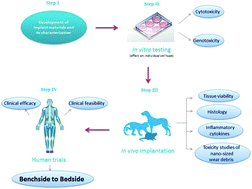In vitro/In vivo assessment and mechanisms of toxicity of bioceramic materials and its wear particulates
Abstract
With the progress in modern technological research, novel biomaterials are being largely developed for various biomedical applications. Over the past two decades, most of the research focuses on the development of a new generation of bioceramics as substitutes for hard tissue replacement. In reference to their application in different anatomical locations of a patient, newly developed bioceramic materials can potentially induce a toxic/harmful effect to the host tissues. Therefore, prior to clinical testing, relevant biochemical screening assays are to be performed at the cellular and molecular level, to address the issues of biocompatibility and long term performance of the implants. Along with testing strategies in the bulk material toxicity, a detailed evaluation should also be conducted to determine the toxicity of the wear products of the potential bioceramics. This is important as the bioceramics are intended to be implanted in patients with longer life expectancy and notwithstanding, the material will eventually release finer (mostly nanosized) sized debris particles due to continuous wear at articulating surfaces in the hostile corrosive environment of the human body. The wear particulates generated from a biocompatible bioceramic may act in a different way, inducing early/late aseptic loosening at the implant site, resulting in osteolysis and inflammation. Hence, a study on the chronic effects of the wear particulates, in terms of local and systemic toxicity becomes the major criteria in the toxicity evaluation of implantable bioceramics. In this broad perspective, this article summarizes some of the currently used techniques and knowledge in assessing the in vitro and in vivo cytotoxicity and genotoxicity of bioceramic implant materials. It also addresses the need to conduct a broad evaluation before claiming the biocompatibility and clinical feasibility of any new biomaterial. This review also emphasizes some of the case studies based on the experimental designs that are currently followed and its importance in the context of clinical applications.


 Please wait while we load your content...
Please wait while we load your content...